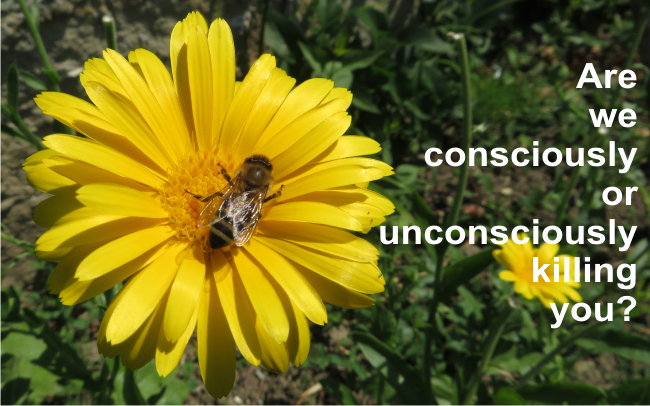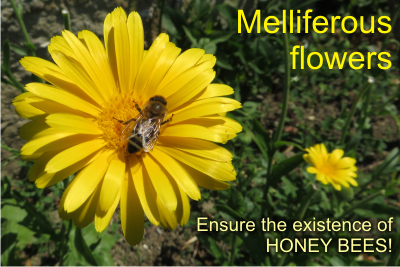On July 2015, The New York Times is writing: “More than 70 percent of pollen and honey samples collected from foraging bees in Massachusetts contained neonicotinoids, a type of insecticide that has been linked to colony collapse disorder, researchers are reporting. The disorder causes adult bees to abandon their hives in winter.”
We got it. Bees disappear. But hey, let’s read it again: the honey contained neonicotinoids! 70% of them!
Considering this moment only, not thinking about the future, or about what is going to pollinate the crops if there are no bees, or other types of insects that “misteriously” die, what happens to our honey?
What happens to the raw honey that we find so hard, and pay so much on?
If honey contains neonicotinoids, how is this affecting our body? How is this affecting my child, who swallows a teaspoon of honey every day, just like many of us did in the childhood, to raise our immunity and sustain our health?
Scientists will say that at these quantities cannot affect our body. But scientists are merely in a phase of their knowledge. They will say different in 10 years. History proved it.
And can we know that this added substance will not alter the honey’s composition and activity? What other reactions will take place inside itself?
What are neonicotinoids?
A pesticide used in the last 20 years to kill pests, especially sap-feeding insects, such as aphids on cereals, and root-feeding grubs. Sap-feeding insects? – We spoke about them when talking about honeydew honey, which is actually made with the help of these sap-feeding insects.
Pesticides can be:
· contact pesticides – which remain on the surface of the foliage,
· systemic pesticides – which are water-soluble and break down slowly in the environment. So, they are taken up by the plant and transported to all its tissues: leaves, flowers, even nectar and pollen, ensuring protection from insects for many weeks. Neonicotinoids belong to this class.
In the UK for example, there are 5 neonicoinoids used in agriculture: acetamiprid, clothianidin, imidacloprid, thiacloprid, and thiamethoxam. They are used for seed treatments for cereals, sugar beet and oil seed rape (around 90% of the area treated with neonics), soil treatment for pot plants in the ornamental sector, treatment for turf in the amenity sector, foliar sprays on apples, pears and a range of glasshouse crops.
Some of them are available to people and are easy to find on the market. Everyone can use them for lawns, houseplants and pot plants and greenhouse crops.
From all these neonicotinoids, clothianidin and imidacloprid are suspected to lead to the current bee declines.
Don’t neonicotinoids degrade quickly?
Not that quickly! It takes 34 days if the plant is exposed to sunlight, and up to 3.8 years if there is no sunlight or micro-organism activity.
What do neonicotinoids do to bees?
They alter the bees’ ability to forage, learn and remember navigation routes to and from food sources. Simply put, they cannot detect where nectar is, and they cannot find the way back to the hive. Bumble bees also suffer from neonicotinoid exposure, negatively impacting their colony growth and queen production.
The study “RFID Tracking of Sublethal Effects of Two Neonicotinoid Insecticides on the Foraging Behavior of Apis mellifera“, by Christof W. Schneider et al., published in 2012, tried to determine the possible sublethal effects interfering with the animal’s vitality and behavioral performance. Their results showed that the bees foraged less while having longer foraging flights, and showed altered behavior during the first three hours after the treatment.
– In the trials conducted with imidacloprid, all or almost all bees of the control groups and the groups treated with doses up to 3 ng returned to the hive after post-treatment release at the feeder, but only a quarter of the bees returned after administration of 6 ng (controls, 0.15 and 1.5 ng: 100%; 3 ng: 95%, 6 ng 25%). Among the bees treated with 3 ng and 6 ng imidacloprid that were not directly flying to the hive, we observed reduced mobility, followed by a phase of motionlessness with occasional trembling and cleaning movements (Movies S1 and S2).
– In the trials conducted with clothianidin, all of the control- and 0.05 ng-bees, and 94.4% of the 0.5 ng-bees returned to the hive during a three-hour observation period immediately after treatment. From the bees treated with 1 ng, only 73.8% returned to the hive, and only 20.6% returned after the uptake of 2 ng. We repeatedly observed abnormal reactions after the release at the feeder site following the administration of 1 ng and 2 ng clothianidin. Bees were moving around with an awkwardly arched abdomen, sometimes followed by a phase of turning upside down and lying on the back with paddling leg movements (Movie S3and S4). Regardless of the administered substance, bees that did not return to the hive within the three-hour period immediately after treatment were neither registered again at the hive nor at the feeder during the following days.
Another 2012 study showed the presence of thiamethoxam and clothianidin in bees found dead in and around hives situated near agricultural fields. Other bees had tremors, uncoordinated movement and convulsions, all signs of insecticide poisoning. The insecticides were found at low levels in soil up to two years after treated seed was planted and on nearby dandelion flowers and in corn pollen gathered by the bees. Insecticide-treated seeds are covered with a sticky substance to control its release into the environment, however they are then coated with talc to facilitate machine planting. This talc may be released into the environment in large amounts. The study found that the exhausted talc showed up to about 700,000 times the lethal insecticide dose for a bee.
“It’s like death by a thousand cuts for these bees” said Greg Hunt, a Purdue University professor of behavioral genetics.
An October 2013 study “Neonicotinoid clothianidin adversely affects insect immunity and promotes replication of a viral pathogen in honey bees, showed that the bees’ immune system is compromised, and they do viral infection, that they normally should NOT do.
If they have been used for the last 20 years, how come only now the bees started to disappear?
That’s a fair question.
People noticed the bee disappearance first in 2006. We call it now colony collapse disorder (CCD) and try to remain as objective as possible. Pesticides are not the only factors that have lead to bees’ disappearance. There are so many factors involved that many studies are still needed to correctly evaluate the influence of neonicotinoids over the bees.
Of course poor hygiene, mites and pathogens, poor nutrition and tough winters have always been the factors that have always killed bees, but it seems that today the situation is worse.
Other people say it’s not the neonicotinoids, but the radiations as well. This, too, can be true. Today’s radiations, all the overlapping electromagnetic fields, all these badly influence the insects’ behavior. To be honest, I’m tempted to believe this, too.
But above all the usual factors that lead to bees’ disappearance, neonicotinoids are added like a cherry on top of a cake. Exactly what was missing from the cocktail.
These conclusions convinced EU to ban some neonicotinoids for specific crops in several European countries, including France, Germany, Italy and Slovenia. They still study the effect of not using them, though there have been lots of complains that the crops were compromised because of pests. We’ll see.
References and further reading:
http://bees.pan-uk.org/neonicotinoids
http://www.collective-evolution.com/2014/05/15/new-harvard-study-proves-why-the-bees-are-all-disappearing/
http://www.theguardian.com/environment/2008/may/23/wildlife.endangeredspecies
https://en.wikipedia.org/wiki/Neonicotinoid#cite_note-DiPrisco2013-62




